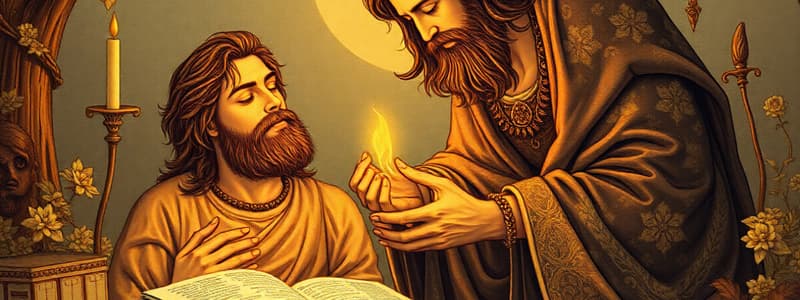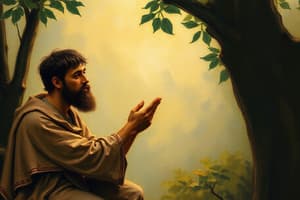Podcast
Questions and Answers
What does the father represent in the Parable of the Prodigal Son?
What does the father represent in the Parable of the Prodigal Son?
- God's unrelenting love and compassion (correct)
- Judgment and punishment
- Human forgiveness
- Material wealth and success
What does the younger son’s journey in the parable primarily symbolize?
What does the younger son’s journey in the parable primarily symbolize?
- Strength and resilience in adversity
- The pursuit of happiness
- Humanity's tendency toward self-destruction and wanderlust (correct)
- The joy of material gain
Why is the older son angry upon his younger brother's return?
Why is the older son angry upon his younger brother's return?
- He disagrees with his father's love for their mother.
- He is jealous of the father's wealth.
- He feels neglected by his father.
- He believes his brother is unworthy of forgiveness. (correct)
What key theme is illustrated by the father's willingness to forgive the younger son?
What key theme is illustrated by the father's willingness to forgive the younger son?
What does the feast in the parable symbolize?
What does the feast in the parable symbolize?
How does the parable encourage self-reflection regarding forgiveness?
How does the parable encourage self-reflection regarding forgiveness?
What does the older son represent in the context of the parable?
What does the older son represent in the context of the parable?
What essential nature of God is emphasized through the Parable of the Prodigal Son?
What essential nature of God is emphasized through the Parable of the Prodigal Son?
How many books are there in the Old Testament?
How many books are there in the Old Testament?
Which category does NOT belong to the Old Testament book classifications?
Which category does NOT belong to the Old Testament book classifications?
Which of the following is the abbreviation for the book of Ecclesiastes?
Which of the following is the abbreviation for the book of Ecclesiastes?
What is the total number of books in the New Testament?
What is the total number of books in the New Testament?
In the abbreviation system, what does 'Ps' stand for?
In the abbreviation system, what does 'Ps' stand for?
Which book is abbreviated as 'Job'?
Which book is abbreviated as 'Job'?
Which set of books does NOT include letters in the New Testament?
Which set of books does NOT include letters in the New Testament?
What is the abbreviation for the Old Testament book of Deuteronomy?
What is the abbreviation for the Old Testament book of Deuteronomy?
Flashcards
The Father
The Father
A symbolic representation of God's unwavering love and forgiveness, embracing even those who have strayed.
The Younger Son
The Younger Son
A character in the Parable of the Prodigal Son who embodies the consequences of sin and spiritual desolation.
The Older Son
The Older Son
Represents those who are judgmental and struggle to understand God's compassion towards those who have strayed.
Repentance
Repentance
Signup and view all the flashcards
Unconditional Love
Unconditional Love
Signup and view all the flashcards
Forgiveness
Forgiveness
Signup and view all the flashcards
Discrimination
Discrimination
Signup and view all the flashcards
The Feast
The Feast
Signup and view all the flashcards
What is the Old Testament about?
What is the Old Testament about?
Signup and view all the flashcards
What is the New Testament about?
What is the New Testament about?
Signup and view all the flashcards
What are the first five books of the Old Testament called?
What are the first five books of the Old Testament called?
Signup and view all the flashcards
What are the first four books of the New Testament called?
What are the first four books of the New Testament called?
Signup and view all the flashcards
Why are Bible book names abbreviated?
Why are Bible book names abbreviated?
Signup and view all the flashcards
What are the different genres of writing found in the Bible?
What are the different genres of writing found in the Bible?
Signup and view all the flashcards
What is the significance of the Bible?
What is the significance of the Bible?
Signup and view all the flashcards
How is the Bible organized?
How is the Bible organized?
Signup and view all the flashcards
Study Notes
Overview of the Parable
- The Parable of the Prodigal Son is a well-known story from the Gospel of Luke (15:11-32).
- It's a powerful narrative about forgiveness, repentance, and the value of family.
- The parable contrasts the attitudes of a father and a younger son toward the prodigal son.
- The parable is found in the New Testament.
Characters in the Parable
- The Father: Represents God's unrelenting love and compassion.
- Younger Son: Symbolizes humanity's tendency toward self-destruction and wanderlust.
- Older Son: Personifies those who are judgmental towards those struggling with sin.
The Plot of the Story
- A father has two sons.
- The younger son, dissatisfied with his inheritance, demands and receives his portion and departs immediately to an unknown land.
- He squanders his inheritance on careless living, eventually finding himself penniless and in dire straits.
- Driven by desperation, he returns home to his father.
- The father, although initially uncertain and apprehensive, welcomes the younger son with open arms.
- The older son, witnessing this encounter, is angered by his father's generosity and empathy.
Symbolic Meanings
- The father's forgiveness exemplifies God's unconditional love for humanity, even for those who have wandered and strayed.
- The prodigal son represents those who have turned away from God; his journey symbolizes the consequences of sin and spiritual desolation.
- The older son reflects the hearts of those who fail to grasp the deep nature of God's compassion and grace.
- The feast represents the celebration of returning to God's grace and mercy.
Key Themes of the Parable
- Unconditional Love: The father's love surpasses any betrayal by the younger son.
- Repentance: The younger son's return demonstrates spiritual transformation.
- Forgiveness: The father's willingness to forgive profoundly affects the younger son's redemption.
- Discrimination: The older son's anger and judgment illustrates the difficulties in accepting repentance.
Connection to Christianity
- The parable emphasizes the essential nature of God's love, even towards those whom we perceive to be unworthy.
- It reinforces the importance of returning to God for healing, forgiveness, and acceptance.
- It encourages self-reflection regarding our own attitudes towards forgiveness and judgment.
- It highlights the importance of extending grace to all who are seeking redemption.
Practical Application
- The parable teaches believers to be gracious and compassionate towards those who have strayed from faith.
- It encourages us to extend forgiveness and love towards others, and avoid being judgmental.
- It reminds us that God desires all to return to Him, regardless of past actions.
- It serves as a powerful reminder of the importance of gratitude for grace and mercy.
Bible Structure
- The Holy Bible is divided into two major sections: the Old Testament and the New Testament.
- The Old Testament contains books primarily focusing on the history, laws, and prophecies of the Jewish people.
- The New Testament details the life, teachings, death, and resurrection of Jesus Christ, as well as the early history of the Christian church.
- Both Testaments contain various genres of writing, including narrative, poetry, prophecy, and letters.
- The Old Testament has 39 books.
- The New Testament has 27 books.
- Books are categorized according to content (e.g., Pentateuch, historical books, poetical books, prophetic books, Gospels, letters, etc.).
- Abbreviations are used to shorten book names for easier referencing (e.g., Gen. for Genesis, Matt. for Matthew).
Studying That Suits You
Use AI to generate personalized quizzes and flashcards to suit your learning preferences.





